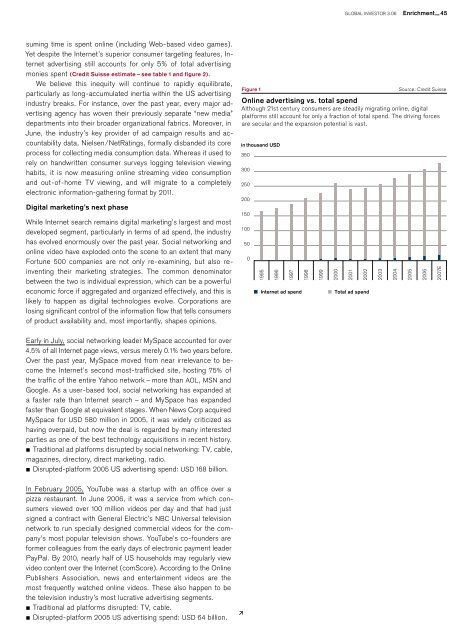Banking for 7 billion and 7 million
New challenges and opportunities of globalization Global Investor, 03/2006 Credit Suisse
New challenges and opportunities of globalization
Global Investor, 03/2006
Credit Suisse
Create successful ePaper yourself
Turn your PDF publications into a flip-book with our unique Google optimized e-Paper software.
GLOBAL INVESTOR 3.06 Enrichment — 45<br />
suming time is spent online (including Web-based video games).<br />
Yet despite the Internet’s superior consumer targeting features, Internet<br />
advertising still accounts <strong>for</strong> only 5% of total advertising<br />
monies spent (Credit Suisse estimate – see table 1 <strong>and</strong> figure 2).<br />
We believe this inequity will continue to rapidly equilibrate,<br />
particularly as long-accumulated inertia within the US advertising<br />
industry breaks. For instance, over the past year, every major advertising<br />
agency has woven their previously separate “new media”<br />
departments into their broader organizational fabrics. Moreover, in<br />
June, the industry’s key provider of ad campaign results <strong>and</strong> accountability<br />
data, Nielsen/NetRatings, <strong>for</strong>mally disb<strong>and</strong>ed its core<br />
process <strong>for</strong> collecting media consumption data. Whereas it used to<br />
rely on h<strong>and</strong>written consumer surveys logging television viewing<br />
habits, it is now measuring online streaming video consumption<br />
<strong>and</strong> out-of-home TV viewing, <strong>and</strong> will migrate to a completely<br />
electronic in<strong>for</strong>mation-gathering <strong>for</strong>mat by 2011.<br />
Digital marketing’s next phase<br />
While Internet search remains digital marketing’s largest <strong>and</strong> most<br />
developed segment, particularly in terms of ad spend, the industry<br />
has evolved enormously over the past year. Social networking <strong>and</strong><br />
online video have exploded onto the scene to an extent that many<br />
Fortune 500 companies are not only re-examining, but also reinventing<br />
their marketing strategies. The common denominator<br />
between the two is individual expression, which can be a powerful<br />
economic <strong>for</strong>ce if aggregated <strong>and</strong> organized effectively, <strong>and</strong> this is<br />
likely to happen as digital technologies evolve. Corporations are<br />
losing significant control of the in<strong>for</strong>mation flow that tells consumers<br />
of product availability <strong>and</strong>, most importantly, shapes opinions.<br />
Figure 1<br />
Source: Credit Suisse<br />
Online advertising vs. total spend<br />
Although 21st century consumers are steadily migrating online, digital<br />
plat<strong>for</strong>ms still account <strong>for</strong> only a fraction of total spend. The driving <strong>for</strong>ces<br />
are secular <strong>and</strong> the expansion potential is vast.<br />
in thous<strong>and</strong> USD<br />
350<br />
300<br />
250<br />
200<br />
150<br />
100<br />
50<br />
0<br />
1995<br />
1996<br />
1997<br />
Internet ad spend<br />
1998<br />
1999<br />
2000<br />
2001<br />
2002<br />
Total ad spend<br />
2003<br />
2004<br />
2005<br />
2006<br />
2007E<br />
Early in July, social networking leader MySpace accounted <strong>for</strong> over<br />
4.5% of all Internet page views, versus merely 0.1% two years be<strong>for</strong>e.<br />
Over the past year, MySpace moved from near irrelevance to become<br />
the Internet’s second most-trafficked site, hosting 75% of<br />
the traffic of the entire Yahoo network – more than AOL, MSN <strong>and</strong><br />
Google. As a user-based tool, social networking has exp<strong>and</strong>ed at<br />
a faster rate than Internet search – <strong>and</strong> MySpace has exp<strong>and</strong>ed<br />
faster than Google at equivalent stages. When News Corp acquired<br />
MySpace <strong>for</strong> USD 580 <strong>million</strong> in 2005, it was widely criticized as<br />
having overpaid, but now the deal is regarded by many interested<br />
parties as one of the best technology acquisitions in recent history.<br />
Traditional ad plat<strong>for</strong>ms disrupted by social networking: TV, cable,<br />
magazines, directory, direct marketing, radio.<br />
Disrupted-plat<strong>for</strong>m 2005 US advertising spend: USD 168 <strong>billion</strong>.<br />
In February 2005, YouTube was a startup with an office over a<br />
pizza restaurant. In June 2006, it was a service from which consumers<br />
viewed over 100 <strong>million</strong> videos per day <strong>and</strong> that had just<br />
signed a contract with General Electric’s NBC Universal television<br />
network to run specially designed commercial videos <strong>for</strong> the company’s<br />
most popular television shows. YouTube’s co-founders are<br />
<strong>for</strong>mer colleagues from the early days of electronic payment leader<br />
PayPal. By 2010, nearly half of US households may regularly view<br />
video content over the Internet (comScore). According to the Online<br />
Publishers Association, news <strong>and</strong> entertainment videos are the<br />
most frequently watched online videos. These also happen to be<br />
the television industry’s most lucrative advertising segments.<br />
Traditional ad plat<strong>for</strong>ms disrupted: TV, cable.<br />
Disrupted-plat<strong>for</strong>m 2005 US advertising spend: USD 64 <strong>billion</strong>.

















